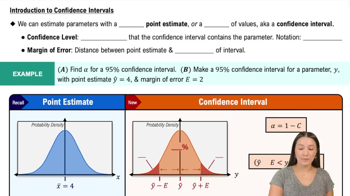Here are the essential concepts you must grasp in order to answer the question correctly.
Confidence Interval
A confidence interval is a range of values, derived from sample statistics, that is likely to contain the true population parameter with a specified level of confidence, typically 95%. It provides an estimate of uncertainty around the sample mean, indicating how much the sample mean might vary from the actual population mean. For example, if a 95% confidence interval for cotinine levels is (1.5, 2.5), we can be 95% confident that the true mean cotinine level lies within this range.
Recommended video:
Introduction to Confidence Intervals
Cotinine Measurement
Cotinine is a metabolite of nicotine and serves as a reliable biomarker for tobacco exposure. Measuring cotinine levels in blood, urine, or saliva allows researchers to assess both active smoking and exposure to second-hand smoke. This measurement is crucial in studies examining the health effects of smoking, as it provides objective data on nicotine exposure rather than relying on self-reported smoking habits.
Recommended video:
Visualizing Qualitative vs. Quantitative Data
Comparative Analysis
Comparative analysis involves evaluating differences between groups to draw conclusions about their characteristics or behaviors. In this context, it refers to comparing the mean cotinine levels among smokers, non-smokers exposed to second-hand smoke, and non-smokers not exposed. This analysis helps to understand the impact of smoking and second-hand smoke on cotinine levels, providing insights into the health risks associated with each group.
Recommended video:
Comparing Mean vs. Median






